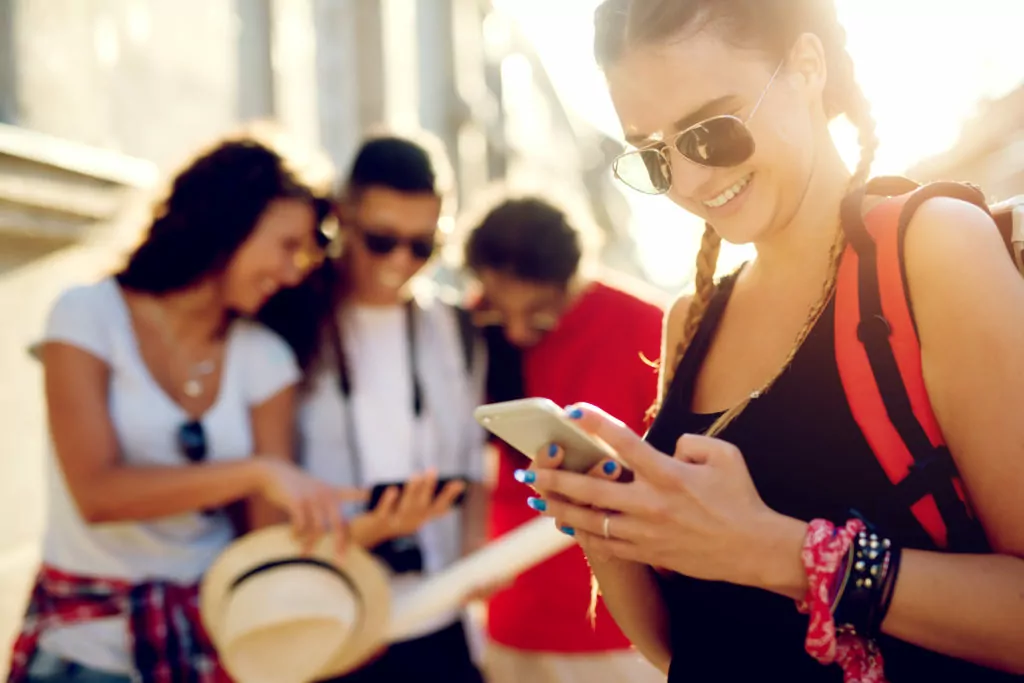Here’s how to turn off location sharing on an iPhone:
There are a number of ways to control location sharing on an iPhone which can include airplane mode.
There are general settings that allow you to turn location sharing on or off altogether.
You can also individually select which apps are allowed to access your location and to what degree.
So if you want to learn all about how to turn off location sharing on Apple devices, then this article is for you.
Let’s get right into it!
How Does Location Sharing Work on iPhones? (2 Things)

Your iOS device is able to track your location and share that information with any number of apps and websites.
First off, here’s how the phone actually keeps track of your location.
It has a GPS chip that can use the global positioning satellite system to figure out where you are.
It can also use Wi-Fi and Cellular connections to triangulate your location based on the signals.
It’s really not necessary to get into the nuts and bolts of how each of these things works.
What matters is that your GPS, cellular connection, or Wi-Fi connection is enough for the phone to know where you are.
If all are active, then the location tracking is that much more accurate.
But, just because your phone knows where you are doesn’t mean that all of your apps and features can track your location.
You actually have direct control over what things on your phone are allowed to know your location.
I’m going to show you exactly how to control these settings, but it’s easier to do it in two parts.
You can control third-party apps and native apps on the phone.
To clarify, a native app is something that comes preinstalled on the phone, like iMessage.
#1 Third Party iPhone Apps Using Location Sharing
You can specifically control the location services for every app you download to an iOS device.
If it doesn’t come preinstalled from Apple, you can consider it a non-native app.
There are a few apps that are made by Apple that aren’t preinstalled, which technically aren’t third-party apps, but I’m going to lump all of that together because they are all controlled the same way.
It’s simpler if I just walk you through it:
- Go to your settings.
- Tap on “Privacy.”
- From there, look for “Location Services.” It’s usually at the top.
- This brings you to the location services settings.
From here, you can control a lot of things.
You can turn off location services for everything (which I mentioned previously).
You can also manage apps individually.
For any app, you have a few options.
You can give it permission to use your location at all times, only while using the app, only after asking, or never.
You can also choose whether or not to give your precise location to the app.
So, if you’re using something like Google Maps to navigate, you might want to give it your precise location.
Meanwhile, an Amazon app for shopping may not need to know exactly where you are.
It’s all up to you, but this is how you directly control location services for all of the third-party apps.
#2 Native iPhone Apps Using Location Sharing
You can control a lot of native apps the same way you do third-party apps, but there are a few key differences.
Some native apps will be listed under the same set of apps in the location services settings.
Others are found when you scroll to the bottom of that list and tap on “System Services.”
This pulls up a second list that controls specific ways the phone might use your location services, and it’s not based on apps anymore.
There are a lot of options here, so I won’t go through them one by one, but here’s the gist.
The way you control these system location services can impact how other apps are able to access your location.
As an example, if you turn off “Location-Based Suggestions,” it could impact any number of apps that use this feature, both native and third-party.
If you are interested in learning how you can tell if someone else has turned off location sharing, we explore that in another article. Read it here.
How Does Do Not Disturb Work on iPhones?

Ok. Location services and sharing settings on your iPhone are the primary way to control who and what can see where you are.
But, there are other settings that can potentially impact location services, so I’ll go through some of those bit by bit.
Some people might assume that Do Not Disturb is one such setting, so let’s talk about how it works.
Do Not Disturb prevents you from getting notifications while it’s activated.
Calls, texts, and app notifications are all silenced (although you can change some of the specifics in the Do Not Disturb settings).
How Does It Impact iPhone Location Sharing & Services?
Based on that, you might think that Do Not Disturb stops location tracking, but that’s not the case.
Even when you have that setting, friends can track you using Find My app, and apps can conceivably use whatever location permissions you allot them.
In fact, Do Not Disturb actually has a location-based feature where it turns on or off when you get to or leave a specified place.
Considering that, it makes sense that location services would still be working normally even while you have Do Not Disturb turned on.
How Does Airplane Mode on an iPhone Work?
Do Not Disturb doesn’t impact location sharing services on iPhone, but what about airplane mode?
When we break down the mechanics of airplane mode together, you’ll get a fair idea.
Airplane mode is designed to turn off communication with your phone.
It cuts off everything except Bluetooth by default.
The idea is to stop all of these communication methods in order to prevent interference with airplane systems.
You can use airplane mode for other reasons, but the original design motivation is why it turns off communications.
Location Sharing in Airplane Mode on iPhone
Since airplane mode turns off Wi-Fi, cellular, and GPS, it’s pretty clear.
It interrupts location services.
So, if you turn on airplane mode, the phone won’t be able to figure out where it is, and it won’t be able to send that information to any other devices or servers.
But, that’s not quite the whole story.
After enabling airplane mode, you can then connect to a Wi-Fi network.
So, you can actually be on Wi-Fi while also in airplane mode.
Airplane mode won’t connect you to Wi-Fi by default, so you’ll have to manually connect after initiating the mode.
If you do, though, then your Wi-Fi connection will be able to generate location data.
Once it does, it will share that data according to your location services preferences.
To clarify, airplane mode will disrupt location sharing on your iPhone, but if you connect to Wi-Fi, you effectively restore that location sharing.
What Other Settings Impact Location Sharing on iPhone? (5 Things)
We’ve already covered the most significant ways to control location sharing on iPhone, but there are other things you can control on the phone that will ultimately impact location services in one way or another.
I’ll take you through each one individually.
#1 Cellular Data
You have an option on your phone to turn off cellular data altogether.
This is a useful feature if you’re trying to preserve data limits on your phone plan.
When you turn off cell data, you don’t completely eliminate the phone’s ability to track your location.
Cellular location tracking is based on pinging the cellular towers that run the network, and even with data turned off, you can make calls and send and receive SMS texts.
So, the cellular network still knows where you are.
But, your iphone will not be sharing your location data to third parties via your cellular connection.
That ability is wrapped up in your cellular data setting.
In simpler terms, when you turn off cellular data, the location data is still generated, but it can’t be shared in this way.
You would need a Wi-Fi connection to maintain most location services.
#2 Wi-Fi
Speaking of Wi-Fi, you can turn that off too.
If you turn off Wi-Fi, then this method of tracking your location becomes unavailable.
The only way you could still maintain location services with Wi-Fi off is through your cellular connection or the built-in GPS.
It’s worth noting that both of those are capable of functioning when Wi-Fi is off.
So, turning off Wi-Fi doesn’t cripple location services, but it makes everything a little harder.
And, if you turn off Wi-Fi in conjunction with turning off GPS and cellular data, then there will be no location tracking or sharing at all with your phone.
#3 iCloud
iCloud preferences are a specific piece of the bigger picture.
You can turn off iCloud, and if you do, location sharing tied to iCloud will no longer function on the iPhone.
That means that you won’t show up on the Find My app if anyone tries to find you.
It also means that iCloud-based location stuff won’t work, such as Photos or Reminders.
This doesn’t impact location services outside of iCloud, so third-party apps will still be able to track you.
But, it does represent a partial block to location sharing.
#4 Pairing
This is really only an issue if you have an Apple Watch that pairs with an iPhone.
If you allow them to pair, then the iPhone can provide location data and services for the watch.
If you unpair them, then the phone cannot do that.
So, if you have location permissions on for the Apple Watch, but it isn’t connected to your phone (and doesn’t have its own connections), then it won’t provide location services.
This is a one-way street, though.
The Apple Watch won’t override the location preferences on your phone.
That said, it is possible to have location services off on one device and not the other.
#5 Emergency SOS
This is the last one, and it’s very specific.
Even if you turn off location sharing for everything else on your iphone, Apple will give your location to emergency services if you call them.
As an example, if you call 911, Apple will share your location with the 911 dispatcher, no matter what settings you have on the phone at the time.
This is considered a safety feature built into the phone, and there is not currently an option for you to override it.
- Why Does My Charger Keep Going On and Off? 6 Troubleshooting Tips
- What is a Lithium Battery? Your Ultimate Guide to Charging and Usage
- Managing iCloud, iCloud Storage Full
- How to Fix an iPhone Not Charging: 9 Awesome Tips
- Why Are My Selfies Backwards on Instagram?
- Do Phones Have IP Addresses: How Hackers Use Them?
- Call Has Been Forwarded: Meaning?
- Snapchat Takes Up So Much Phone Storage: Why?
- Consumer Cellular Voicemail Password: How to Recover?
- Changing Apple ID: Pros and Cons?


